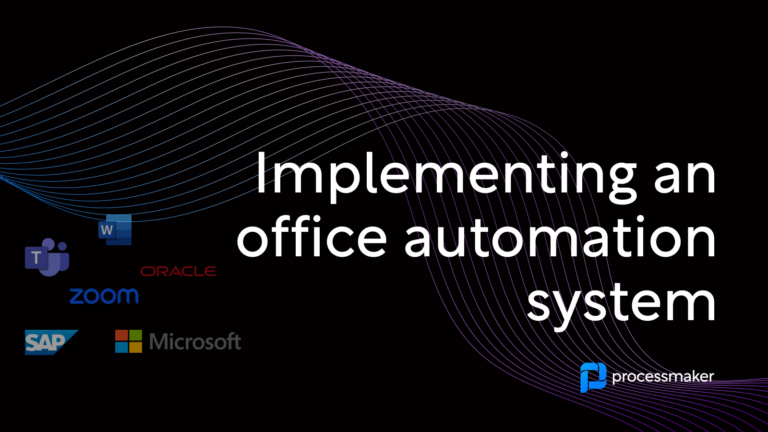Is your business struggling with a decline in productivity? Is your organization considering automation implementation in the workplace? Here’s why you should.
In this article, we explore what an office automation system is and the benefits that it offers. From there, we’ll assess the implementation process and highlight some important features that you should look for in an office automation system.
What is an office automation system?
So what is an office automation system anyway? We’re living in an increasingly automated world, but that doesn’t mean that the concept is self-explanatory. To start, the system consists of both hardware and software solutions.
These integrations enable the transfer of data between systems that lack human contribution or interventions. Furthermore, office automation eases organizational workloads by simplifying and automating processes. These processes include financial services, data management, training, facility management, and various administrative tasks.

Benefits of an office automation system
Now let’s talk benefits. Implementing an office automation system offers organizations a broad range of advantages. These improvements include:
- Improved accuracy
- Reduced costs
- Reduced time and resources
- Data storage and management
- Data insights and more informed decisions
- Business process improvement
Improved accuracy
It’s no secret that human error exists, but properly implemented automated systems rarely err. Human errors call for corrections, which stunts efficiency and delays productivity, often resulting in costly consequences.

Imagine adding too many digits when paying an employee or vendor. Serious mistakes can lead to security and compliance issues, potentially fines and penalties. An office automation system limits human intervention in the transfer of data, which minimizes the occurrence of errors.
Reduced costs
By automating complex business processes, organizations no longer need to invest as much into hiring. As a result, operational costs are lower, while productivity and profit margins are significantly higher.
Reduced time and resources
Through automation, organizations can accomplish more with less.
By eliminating tedious and time-consuming processes, employees can spend their time on more high-value tasks. With office automation, software employees don’t waste time collecting important documentation, entering that information, or filing away voluminous paper copies.
The system does it for them. In fact, McKinsey suggests that AI automation could take 60-70% of today’s work activity by 2045.
Data storage and management
Office automation systems simplify data storage, giving organizations the ability to monitor and control data through an electronic document management system. Common features include things like task management and reminder systems, as well as easy access to information by key stakeholders.
Data insights and more informed decisions
Office automation systems provide organizations access to large data sets, reports, and analytics. Access to data enables more informed decisions. Moreover, by analyzing data and key performance indicators, organizations can implement improvements to their processes to remove bottlenecks and other inefficiencies.

Through business process automation (BPA), organizations optimize performance, improve the quality of their products or services, and ensure a higher level of compliance. The ability to improve business processes is what separates office automation systems from piecemeal automation technology.
How to implement an office automation system
The benefits of hyperautomation are easy enough to understand and appreciate. Just about every organization in the world would welcome improved accuracy, greater efficiency, and higher profit margins. Yet, many organizations don’t make the jump to business process management software because the process seems overwhelming. The learning curve can seem daunting, but luckily, some platforms are making business process design easier than ever.
With an ordered approach, implementation is both manageable and achievable.
Deciding what to automate
Before implementing automation in the workplace, the organization will need to spend time looking at which specific business processes will need to be intelligently automated. Begin by looking at existing workflows to gain an understanding of the processes, stakeholders, and resources involved.
If you don’t want to manually look at all the existing processes, spending months of people’s work, then one of the easiest ways to go about examining your workflows is through process intelligence. Advanced process intelligence tools like that of ProcessMaker provide a full transparency into all organizational processes. The software shows how workflows are currently executed, what are the inefficiencies and bottlenecks, and produces actionable insights into what should be improved.
CTA If you want to learn all about process intelligence and understand the technology behind, make sure to read this whitepaper.
Key features of an office automation system
There are countless applications and software programs that promise improved efficiency through intelligent process automation. As we discussed above, however, achieving organizational efficiency through an office automation system requires more than downloading a few apps. Rather, you need a comprehensive office automation solution that offers the following features:
Process modeling and workflow design
An important benefit of an office automation system is the ability to design and improve process flows. The solution that you choose should give you the ability to create detailed workflows in a matter of mere seconds. One of ProcessMaker’s latest AI-powered features is the ability to map and document processes without having to draw or design anything. The software does it automatically based on the short process description.

Integration
One of the biggest day-to-day challenges that organizations face when attempting to automate their processes is integrating various third-party software or apps. Your office automation system should work seamlessly with your other tools like email marketing and your CRM system. Business process automation tools like ProcessMaker have simplified the process of building custom integrations.
Access control and security
To protect the security of your systems, you need to be able to set access privileges throughout the organization. Cloud-based solutions also offer advanced security features to protect data from being compromised.
Communication
An important feature of any automation tool is the ability to communicate seamlessly. Stakeholders should have all the information they need to perform business operations, as well as the ability to reach out to others for further assistance. Your office automation platform should offer features like a form builder. Form builders can be used to capture data, display data from other systems, and even design approval screens for managers to make decisions.
Reporting and analytics
To evaluate and improve your office automation system, you need to have access to data and key performance indicators. Leading office automation systems have built-in reporting and analytics capabilities.
How does an office automation system generate hyperproductivity?
Implementing an office automation system is a key driver of productivity and effectiveness in modern workplaces. Such systems streamline routine administrative tasks, such as document management, communication, and data processing, allowing employees to dedicate their time and energy to more strategic and creative endeavors. By automating workflows and processes, employees can work more efficiently and with reduced errors.
Ready to start your automation journey? Connect with one of our experts to unlock your productivity transformation.





